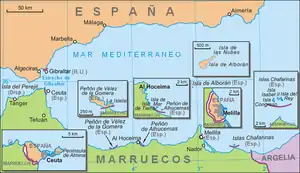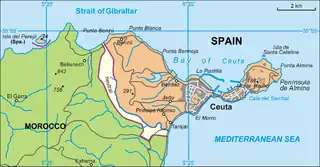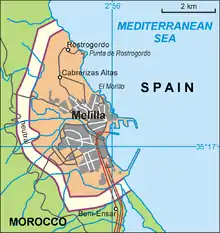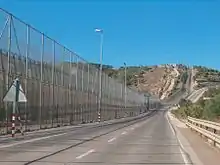Morocco–Spain border
The Morocco–Spain border consists of three non-contiguous lines totalling 18.5 km (11.5 m) around the Spanish territories of Ceuta (8 km), Peñón de Vélez de la Gomera (75 metres) and Melilla (10.5 km). These three exclaves form part of Spain's plazas de soberanía, which also includes a number of small islands off the Moroccan coast.
| Morocco–Spain border | |
|---|---|
 Spain's plazas de soberanía along the coast of Morocco | |
| Characteristics | |
| Entities | |
| Length | 18.5 kilometres (11.5 mi) |
| History | |
| Established | 1860-62 |
History
Historically the plazas de soberanía were part of various Muslim empires of north-west Africa.[1] Ceuta was conquered by Portugal in 1415.[2] Following the Reconquista of the Iberian peninsula, Spain looked south to the North African coast, capturing Melilla from the Sultanate of Fez in 1497, with Portugal’s blessing.[1] Spain took the then-island of Peñón de Vélez de la Gomera by force in 1508, with Portugal recognising this claim the following year with the Treaty of Cintra.[1] Retaken by the Kingdom of Fez in 1554, Spain reconquered it in 1564, and it has remained in Spanish hands since that time.
During the period of Iberian Union (1580-1640) Ceuta attracted many Spanish settlers; as a result, when Portugal regained its independence from Spain in 1640 Ceuta opted to remain with Spain, a situation Portugal acquiesced to in 1688 with the Treaty of Lisbon.[1][3] A treaty outlining Ceuta's boundary with Morocco was signed 7 October 1844 and confirmed by another on 6 May 1845.[3][1] A treaty outlining the Melilla-Morocco boundary, replete with a parallel ‘neutral zone’, was signed 24 August 1859.[3][4]
Repeated Moroccan attempts to wrest back control of the two exclaves by force during the 18th-19th centuries failed, culminating in the Hispano-Moroccan War of 1859-60, which resulted in a Spanish victory. The subsequent Treaty of Wad-Ras (aka the Treaty of Tétouan) of 26 April 1860 expanded the border of Ceuta its present limit.[3] Melilla’s border was supposed to be fixed by 'the range of a piece of cannon', however this proved impractical, and a further treaty was therefore signed on 30 October 1861 and confirmed on 26 June 1862 which outlined the modern boundary line.[4][3][1][5] Localised disputes in Melilla continued however, and further treaties were signed in 1894-95.[1]
By a Franco-Spanish treaty of 27 November 1912, Spain was granted a protectorate over Morocco’s Mediterranean littoral, referred to as Spanish Morocco.[6] Ceuta, Peñón de Vélez de la Gomera and Melilla thereafter were absorbed into this entity. When Morocco gained independence from France in 1956, Spanish Morocco was handed to the new kingdom.[1] However Spain maintained control of the plazas de soberanía, asserting that they were Spanish territory long before the creation of the protectorate in 1912 and should therefore remain part of Spain, a position bitterly contested by Morocco.[1][7][8]
In 1934 a huge storm created a tombolo between Peñón de Vélez de la Gomera and the Moroccan mainland, effectively making the former island a new Spanish exclave on the coast of Morocco. It does not appear a formal border treaty was ever signed between Morocco and Spain, and a short 75m straight line throughout the sandy spit connecting it to Morocco has functioned as a de facto frontier since that time.[9]
Since Moroccan independence the dispute over the plazas de soberanía has flared up from time-to-time, most notably in 1975 when it was feared Morocco would attempt an invasion of the territories similar to the Green March invasion of Western Sahara conducted that same year.[1] At present Spain remains in control of the plazas and refuses to discuss the issue of their sovereignty with Morocco.[1]
In 1993 Spain began building the Ceuta border fence and Melilla border fence, which were further strengthened in 1995.[10] In response to an increase in the number of migrants attempts to breach the fence, both were significantly fortified in 2005, creating a doubled-fence system replete with barbed wire and surveillance equipment.[11] Since then there have been numerous attempts to cross the fences, resulting in several fatalities.[12]
Maritime borders
Morocco and Spain also share a maritime border in the Canary Islands area and along the Strait of Gibraltar and the Alboran Sea. The shortest distance between land along the Strait of Gibraltar is 14.3 kilometres (8.9 mi; 7.7 nmi). The British territory of Gibraltar (claimed by Spain) is located on the northern coast of this strait.
Gallery
 Map of Ceuta
Map of Ceuta The Ceuta border fence as it enters the sea
The Ceuta border fence as it enters the sea The Ceuta border fence
The Ceuta border fence Map of Melilla
Map of Melilla The Farjana-Melilla border crossing
The Farjana-Melilla border crossing The Melilla border fence
The Melilla border fence Peñón de Vélez de la Gomera; the border runs along the grey sand spit where the boats are laid
Peñón de Vélez de la Gomera; the border runs along the grey sand spit where the boats are laid
See also
References
- Gerry O’Reilly (1994), Ceuta and the Spanish Sovereign Territories: Spanish and Moroccan Claims, Durham University – IBRU, retrieved 26 January 2020
- Payne, Stanley G., A History of Spain and Portugal, Vol. 1, Chap. 10 "The Expansion"
- Spanish territorial boundaries in northwest Africa (PDF), 10 February 1958, retrieved 26 January 2020
- Robert Rézette (1976). The Spanish Enclaves in Morocco. Nouvelles Editions Latines. pp. 125–26.
- Acta de demarcación de los límites de la plaza de Melilla: firmada en Tánger el 26 de Junio de 1862. Y acuerdo relativo a la conservación de las señales de aquéllos: firmado en Draa-Es-Seyet (enfrente a Melilla) el 14 de noviembre de 1863, retrieved 26 January 2020
- Treaty Between France and Spain Regarding Morocco, in: The American Journal of International Law, vol.7, no.2, Apr. 1913
- "Morocco Restates Claim to Ceuta and Melilla". Expatica. 1 February 2006. Retrieved 18 May 2018.
- "Gibraltar in Reverse". The Economist. 21 February 2002. Retrieved 18 May 2018.
- Lewis, Martin W. (30 Aug 2010). "The World's Shortest Border". GeoCurrents. Archived from the original on 11 August 2018. Retrieved 22 June 2019.
- Said Saddiki (2017). The Fences of Ceuta and Melilla in World of Walls: The Structure, Roles and Effectiveness of Separation Barriers. Open Book Publishers. pp. 125–26.
- Building Fortress Europe? Schengen and the Cases of Ceuta and Melilla
- "Spain: Accountability urged for 'appalling' migrant deaths in Ceuta". Amnesty International. Retrieved 8 November 2014.